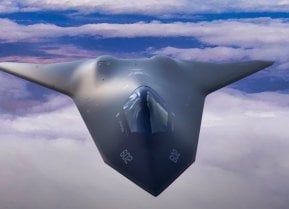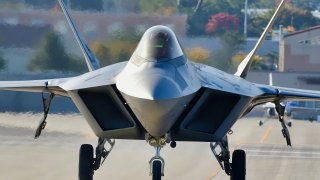The Air Force's War on the F-22 Raptor is a Mistake
The U.S. Air Force's plan to retire 32 F-22 Raptor Block 20 warplanes has sparked a conflict with Congress, which proposes upgrading them instead.
Summary and Key Points: The U.S. Air Force's plan to retire 32 F-22 Raptor Block 20 warplanes has sparked a conflict with Congress, which proposes upgrading them instead.
-Critics argue the Air Force is pushing for this retirement to secure funding for the costly Next Generation Air Dominance (NGAD) program.
-The Government Accountability Office has highlighted the Air Force's lack of a thorough investigation into the costs and impacts of this move, raising concerns about misleading Congress to favor the NGAD.
Air Force vs. Congress: The Battle Over Retiring F-22 Raptors
There is a bizarre fight going on between the U.S. Air Force and Congress over the fate of thirty-two F-22 Raptor Block 20 warplanes. The Air Force wants to retire these birds, while Congress insists the service should continue using them.
One proposal suggests that the Air Force upgrade these warplanes.
Of course, the Air Force is too focused on building its wünderwaffe. Nevermind that the F-22 – any F-22 – is the most advanced warplane in existence (and likely will continue to be for another 20 years). The Pentagon is convinced it needs to start retiring a bird that was one of the most expensive ever built – a plane that has only been in service for about 30 years.
The Air Force's War on the F-22 is a Tragic Affair
The Air Force has somehow managed to make systems older than the F-22 last far longer. Think of the iconic B-52 Stratofortress bomber. Here is a bird that’s been flying since President Harry Truman was in office.
While they have had some upgrades, the bombers of this class flying today are basically the same as the ones that flew at the start of the Cold War. And the Air Force plans to keep them flying until the middle of this century, giving the B-52 a 100-year operational lifespan.
Even the F-15, the fourth-generation air superiority fighter that the F-22 was intended to replace, had its lifespan drastically extended. Today, the Air Force not only operates the F-15, but they’ve created an entirely upgraded variant of it, the F-15EX Eagle II. What’s more, the Air Force basically maintains their entire fleet of fourth-generation warplanes, despite having flown the F-22 Raptor since the mid-1990s.
That’s because the F-22, despite its incredible technology and sophistication, is an expensive plane to build and maintain. It was so expensive that the Air Force, under the orders of former President Barack Obama, decided to prematurely cut the production line of the F-22 in order to cut costs during the 2008 financial crisis.
With that production line ended, the Air Force had less than one-third of the 750 planes it had originally planned to build to replace its aging fourth-generation warplane fleet.
For more than a decade after the cancellation of the F-22 production line, the Air Force existed in this weird gray zone between fully transitioning to the fifth-generation warplane as it had planned, and having to keep its older planes flying.
Now, the Air Force is transfixed on its Next Generation Air Dominance (NGAD) project combining a sixth-generation warplane with next-generation drone capabilities.
It is a wild concept and a ghastly, unnecessary expenditure.
Air Force, Stop Trying to Make the Wünderwaffe Happen. It's Not Going to Happen!
The Air Force’s cost-saving measures in anticipation of funding NGAD include retiring older warplanes. Already, the Air Force has been retiring fourth-generation systems at such a rate that they might be creating strategic gaps in the force.
Now the executioner’s blade is moving toward the F-22. Specifically, the tranche of 32 older F-22s, the Block 20s. These were the first-generation F-22 Raptors. They were never upgraded, because they are used as training planes for the Air Force. But if these older, original F-22s are retired, then the Air Force will have no planes available for future F-22 pilots to train on.
And that, of course, is the point.
They’re purposely angling to prevent the continuation of the F-22 Raptor program so as to force Congress’ hand in funding NGAD.
The Government Accountability Office picked up on this fact immediately. For some time, Congress has requested information on how retiring all thirty-two Block 20 F-22s might harm the force by impinging on its readiness.
Congress wanted the Air Force to detail some of the alternatives to retirement, what the costs would be, and the wider implications for the Air Force’s structure.
But the Air Force dragged its bureaucratic boots. According to the GAO report, the Air Force did not conduct a data-driven investigation to answer Congress’ important queries about the Air Force’s stubborn commitment to divesting from the Block 20s.
Instead, the Air Force simply asked their primary contractor, Northrop Grumman, what the cost of potentially upgrading the Block 20s, as opposed to retiring them, would be. Without providing any evidence for their determination, Northrop told the Air Force that it would take 15 years and cost $3.3 billion to upgrade those planes.
The Air Force, which absolutely does not want the F-22s anymore, took Northrop’s determination and transmitted that to Congress without verifying its accuracy. Of course, it was not accurate. But the Air Force and the interlocking cabal of defense contractors want the big payday that will come with an investment in the NGAD’s development over the next decade.
Is the Air Force Misleading Congress?
Interestingly, the GAO concluded that, “Without better evidence about the potential either divesting or upgrading F-22 Block 20 aircraft, Congress may be impeded from making well-informed decisions on the merits of the Air Force’s proposal.”
In other words, the military is obstructing a congressional inquiry in order to manipulate Congress into funding their irresponsible NGAD program.
It's a travesty, and heads should roll for this. Of course, they won’t. This is just standard operating procedure in a Washington that is both overflowing with the hard-earned tax dollars of Americans as well as drowning in special interests.
Still, it would be nice if someone in power could actually see through the schemes and stop them before taxpayers are made to pay for yet another boondoggle.
Author Experience and Expertise: Brandon J. Weichert
Brandon J. Weichert, a National Interest national security analyst, is a former Congressional staffer and geopolitical analyst who is a contributor at The Washington Times, the Asia Times, and The-Pipeline. He is the author of Winning Space: How America Remains a Superpower, Biohacked: China’s Race to Control Life, and The Shadow War: Iran’s Quest for Supremacy. His next book, A Disaster of Our Own Making: How the West Lost Ukraine, is due October 22 from Encounter Books. Weichert can be followed via Twitter @WeTheBrandon.
All images are Creative Commons.
From the Vault
Russia Freaked Out: Why the U.S. Navy 'Unretired' the Iowa-Class Battleships
Battleship vs. Battlecruiser: Iowa-Class vs. Russia's Kirov-Class (Who Wins?)


